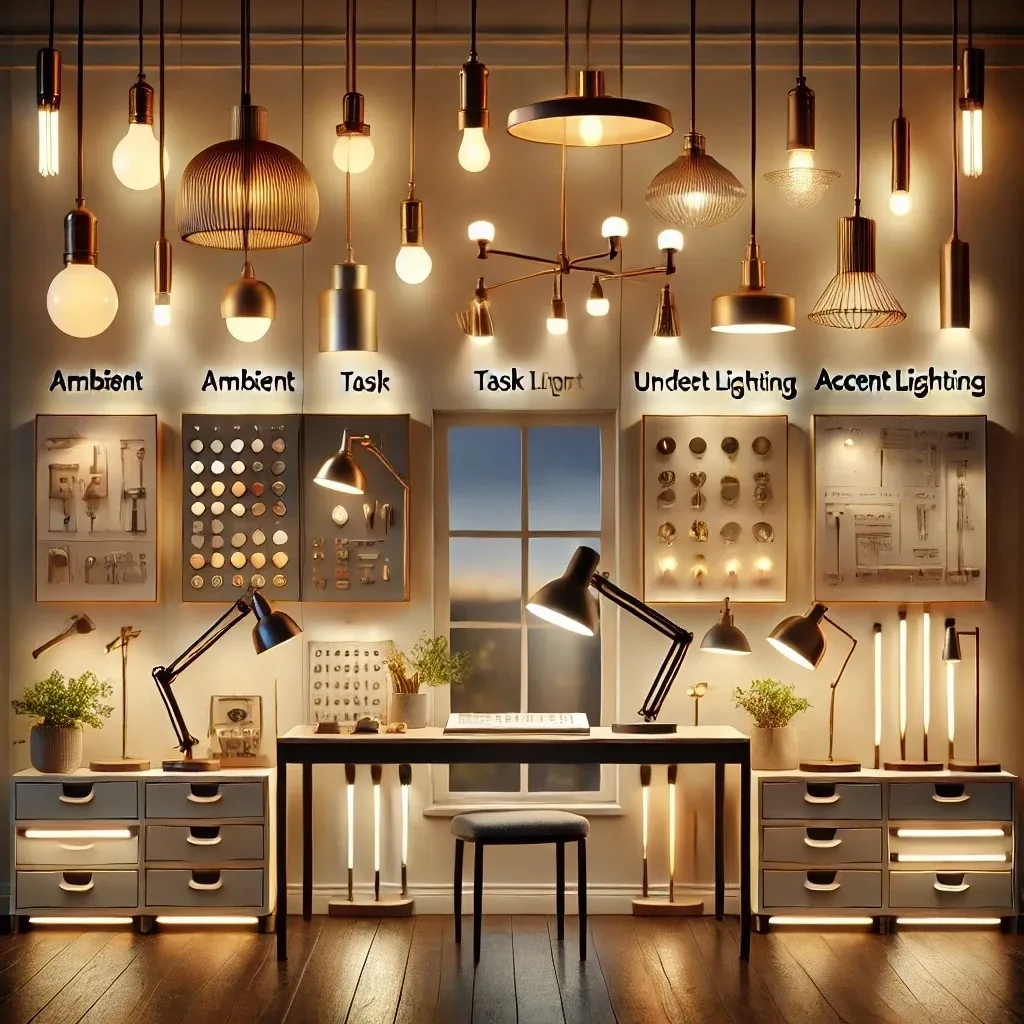In interior design, lighting plays a crucial role in setting the mood, enhancing aesthetics, and improving functionality. There are various types of lighting techniques and fixtures, each serving distinct purposes. Here’s an overview of the different types of lighting commonly used in interior design:
1. Ambient Lighting
Ambient lighting, often referred to as general lighting, provides overall illumination for a room. It’s the base layer that fills the room with a comfortable level of brightness without creating harsh shadows.
Sources: Ceiling fixtures, chandeliers, recessed lighting, track lights.
Purpose: Ensures safe navigation and an even level of light throughout the space.
Best Uses: Living rooms, bedrooms, and kitchens to provide foundational light.
2. Task Lighting
Task lighting is focused, bright light directed at specific areas where activities like reading, cooking, or working take place. It’s essential for precision tasks that require concentrated light without straining the eyes.
Sources: Desk lamps, under-cabinet lighting, pendant lights over a kitchen island, vanity lights.
Purpose: Enhances productivity and reduces eye strain during tasks.
Best Uses: Home offices, kitchen counters, reading areas, and makeup stations.
3. Accent Lighting
Accent lighting is used to highlight specific features in a room, such as artwork, sculptures, architectural details, or plants. This lighting type adds depth and dimension, making the highlighted items a focal point.
Sources: Spotlights, track lighting, wall-mounted fixtures, picture lights.
Purpose: Adds drama and visual interest, directing attention to specific decor elements.
Best Uses: Living rooms, hallways, art galleries, and spaces where aesthetics are prioritized.
4. Decorative Lighting
This type of lighting doubles as a decorative element. While it may provide some illumination, its main purpose is to enhance the room’s style and aesthetic.
Sources: Chandeliers, pendant lights, string lights, sculptural fixtures.
Purpose: Acts as a decorative piece that enhances the room’s design theme.
Best Uses: Dining rooms, entryways, bedrooms, and living rooms.
5. Natural Lighting
Maximizing natural light is a fundamental element in interior design. Windows, skylights, and glass doors bring in sunlight, reducing the need for artificial light during the day.
Sources: Windows, skylights, glass doors.
Purpose: Improves mood, saves energy, and brings out true colors in the decor.
Best Uses: Any room, especially living spaces and kitchens, to create an open, inviting feel.
6. Layered Lighting
Layered lighting combines different lighting types within a single space to create a balanced and dynamic environment. It ensures that rooms have adequate lighting for various functions and moods.
Sources: A combination of ambient, task, and accent lights.
Purpose: Provides versatility by offering different lighting options for different times of day and activities.
Best Uses: Living rooms, dining rooms, and bedrooms to enhance comfort and flexibility.
7. Cove Lighting
Cove lighting is an indirect form of lighting installed in ledges, recesses, or valances. It directs light toward the ceiling or walls, creating a soft, diffused glow that enhances the room’s ambiance.
Sources: LED strips, rope lights, or hidden fluorescent lights.
Purpose: Adds a sense of height, drama, and warmth to the room.
Best Uses: Bedrooms, living rooms, and dining rooms to create an elegant or cozy atmosphere.
8. Wall Sconces
Wall sconces are mounted on walls to provide localized light. They are versatile, available in various styles, and used to highlight specific areas or add decorative flair.
Sources: Wall-mounted fixtures with various styles, from classic to modern.
Purpose: Adds style while enhancing visibility in targeted spots.
Best Uses: Hallways, bathrooms, bedside areas, and living rooms for added visual interest.
9. Pendant Lighting
Pendant lights are single fixtures suspended from the ceiling. They can be used for ambient, task, or decorative lighting, depending on the style and placement.
Sources: Single or grouped pendant lights, often adjustable.
Purpose: Adds direct light and a visual focal point.
Best Uses: Kitchens (over islands), dining tables, and entryways for balanced and stylish lighting.
10. Track Lighting
Track lighting consists of several lights mounted on a track system, allowing them to be adjusted individually. This type is highly versatile and ideal for directing light to different areas or objects.
Sources: Track systems with adjustable heads, often installed on ceilings.
Purpose: Provides flexibility in directing light, making it suitable for rooms with changing needs.
Best Uses: Art displays, kitchens, and multi-functional spaces for customizable lighting.
11. Recessed Lighting
Recessed lights are fixtures set into the ceiling for a sleek, unobtrusive look. They’re excellent for providing ambient lighting or accent lighting when angled toward a specific area.
Sources: Built-in ceiling lights with adjustable or fixed trims.
Purpose: Provides a clean, modern look with consistent, diffused light.
Best Uses: Kitchens, bathrooms, hallways, and living rooms for subtle illumination.
12. Floor and Table Lamps
These portable lighting options are ideal for adding both function and style. They’re easy to move and come in a wide range of designs.
Sources: Standing lamps, reading lamps, bedside lamps.
Purpose: Adds flexible, focused, or ambient light based on needs.
Best Uses: Living rooms, bedrooms, and offices for added lighting flexibility and style.
13. Smart Lighting
Smart lighting uses technology to adjust light levels, colors, and schedules through devices like smartphones or voice assistants. This type of lighting provides both convenience and versatility.
Sources: Smart bulbs, connected switches, or integrated smart lighting systems.
Purpose: Allows for personalized control, enhancing comfort and energy efficiency.
Best Uses: Any room for convenient, adaptive lighting based on time of day or mood.
Each type of lighting has its unique role, and combining them effectively can create a well-balanced and visually engaging space.

